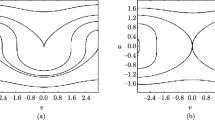Abstract
Hamiltonian systems with 3/2 degrees of freedom close to non-linear autonomous are studied. For unperturbed equations with a nonlinearity in the form of a polynomial of the fourth or fifth degree, their coefficients are specified for which the period on closed phase curves is not a monotone function of the energy and has extreme values of the maximal order. When the perturbation is periodic in time, this non-monotonicity leads to the existence of degenerate resonances. The numerical study of the Poincaré map was carried out and bifurcations related to the formation of the vortex pairs within the resonance zones were found. For systems of a general form at arbitrarily small perturbations the absence of vortex pairs is proved. An explanation of the appearance of these structures for the Poincaré map is presented.
Similar content being viewed by others
References
Morozov, A.D. and Shil'nikov, L.P., On Nonconservative Periodic Systems Similar to Two-Dimensional Hamiltonian Ones, Prihl. Mat. Mehh., 1983, vol. 47, no. 3, pp. 385–394 [J. Appl. Math. Mech. (Engl. transl.), 1984, vol. 47, no. 3, pp. 327–334]. (See also book [3].)
Morozov, A.D., On Degenerate Resonances in Nearly Hamiltonian Systems, Regul. Chaotic Dyn., 2004, vol. 9, no. 3, pp. 337–350.
Morozov, A.D., Quasi-Conservative Systems: Cycles, Resonances and Chaos, World Sci. Series on Nonlinar Science, Ser. A}, vol. 30, World Sci., 1998.
Morozov, A.D., Resonances, Cycles and Chaos in Quasi-Conservative Systems, Moscow-Izhevsk: Regular and Chaotic Dynamics, 2005, 422 pp. (in Russian).
Morozov, A.D. and Boykova, S.A., On Investigation of Degenerate Resonances, Regul. Chaotic Dyn., 1999, vol. 4, no. 1, pp. 70–82.
Soskin, S.M., Luchinsky, D.G., Mannella, R., Neiman, A.B., and McClintock, P.V.E., Zero-Dispersion Nonlinear Resonance}, 1997, vol. 7, no. 4, pp. 923–936.
Howard, J.E. and Humpherys, J., Nonmotonic Twist Maps, Physica D, 1995, vol. 80, no. 3, pp. 256–275.
Petrisor, E., Reconnection scenarios and the threshold of reconnection in the dynamics of non-twist maps, Chaos, Solitons and Fractals, 2002, vol. 14, pp. 117–127.
Wurm, A., Apte, A., Fuchss, K., and Morrison, P.J., Meanders and reconnection-collision sequences in the standard nontwist map, Chaos, 2005, vol. 15, 023108, 13 pp.
Morozov, A.D. and Dragunov, T.N., Visualization and Analysis of Invariant Sets for Dynamical Systems, Moscow-Izhevsk: SPC “Regular and Chaotic Dynamics”, 2003 (in Russian).
Wintner, A., Analytical Foundations of Celestial Mechanics, Princeton Mathematical Series, vol. 5, Princeton, N.J.: Princeton University Press, 1941.
Morozov, A.D., Degenerate Resonances in Hamiltonian Systems with 3/2 Degrees of Freedom, Chaos, 2002, vol. 12, no. 3. pp. 539–548.
Author information
Authors and Affiliations
Corresponding author
Rights and permissions
About this article
Cite this article
Morozov, A.D. On degenerate resonances and “vortex pairs”. Regul. Chaot. Dyn. 13, 27–37 (2008). https://doi.org/10.1007/s11819-008-1004-2
Received:
Accepted:
Published:
Issue Date:
DOI: https://doi.org/10.1007/s11819-008-1004-2



